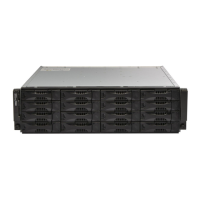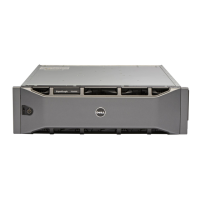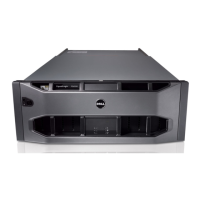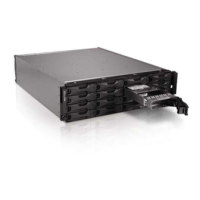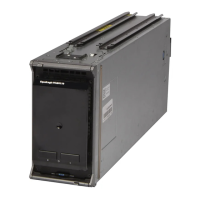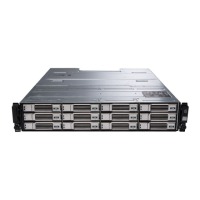Do you have a question about the Dell PS4000 and is the answer not in the manual?
Identifies the intended readers for the configuration guide.
Outlines the organization and sections of the configuration guide.
Lists and describes different Dell EqualLogic PS Series array models and their features.
Compares features and scalability across different EqualLogic PS Series array models.
Details the various controller types and their characteristics.
Explains controller redundancy, failover process, and IP address reassignment.
Explains the EqualLogic PS Series firmware versioning and update process.
Details RAID 5 implementation, drive layouts, and storage availability.
Details RAID 6 implementation, drive layouts, and storage availability.
Details RAID 10 implementation, drive layouts, and storage availability.
Details RAID 50 implementation, drive layouts, and storage availability.
Defines a SAN Group, its members, and firmware version requirements.
Describes pools as containers for members and their role in tiered storage.
Explains volumes as the storage allocation structure within an EqualLogic SAN.
Details volume naming conventions and iSCSI Qualified Name (iqn) structure.
Lists features and capabilities supported by EqualLogic volumes.
Explains thin provisioning for managing data growth and its rules.
Describes snapshots as point-in-time copies and their characteristics.
Details the process of creating new volumes by copying existing ones.
Explains replication for disaster recovery and its design topology limits.
Discusses enabling concurrent access to volumes for shared storage environments.
Details the IETF and IEEE standards that EqualLogic SANs are based on.
Outlines general requirements and best practices for SAN design.
Explains Quality of Service and Dell's recommendations against its use on SANs.
Explains methods for interconnecting switches in a Layer 2 SAN network.
Provides guidelines for determining appropriate inter-switch connection bandwidth.
Compares stacking and Link Aggregation Groups (LAGs) for inter-switch connections.
Details server NIC configurations for redundant SAN connectivity.
Explains the requirement and configuration of MPIO for host connectivity.
Illustrates a fully redundant iSCSI SAN configuration for production environments.
Shows reference configurations for partially redundant SANs, not for production.
Provides guidelines for blade server integration and switch stacking in chassis.
Details switch stacking for a single M1000e enclosure.
Explains configurations for multiple M1000e enclosures and I/O module stacking.
Provides recommendations for 10GbE uplinks from blade I/O modules to external switches.
Provides recommendations for 1GbE uplinks from blade I/O modules to external switches.
Details the essential ports and protocols for EqualLogic iSCSI SAN operation.
Lists optional ports and protocols used for management and alerts.
Provides a list of recommended 1GbE switches and their tested firmware levels.
Provides a list of recommended 10GbE switches and their firmware.
Details supported hardware iSCSI initiators (HBAs) and their operating systems.
Lists supported software iSCSI initiators and their operating system versions.
Lists supported network interface controllers (NICs) and their driver/OS versions.
Details how to disable the iSCSI Optimization setting on 54xx switches.
Explains how to enable PortFast for STP edge ports on 54xx switches.
Details how to enable flow control on 54xx switches.
Explains how to disable unicast storm control on 54xx switches.
Details how to enable jumbo frames on 54xx switches.
Explains the interface naming conventions for PowerConnect 62xx switches.
Details enabling PortFast for STP edge ports on 62xx switches.
Details how to enable flow control on 62xx switches.
Explains how to disable unicast storm control on 62xx switches.
Details how to enable jumbo frames on 62xx switches.
Details enabling PortFast for STP edge ports on Cisco IOS switches.
Explains how to configure flow control on Cisco Catalyst switches.
Details how to disable unicast storm control on Cisco IOS switches.
Explains how to configure jumbo frames on Cisco Catalyst switches.
Identifies the intended readers for the configuration guide.
Outlines the organization and sections of the configuration guide.
Lists and describes different Dell EqualLogic PS Series array models and their features.
Compares features and scalability across different EqualLogic PS Series array models.
Details the various controller types and their characteristics.
Explains controller redundancy, failover process, and IP address reassignment.
Explains the EqualLogic PS Series firmware versioning and update process.
Details RAID 5 implementation, drive layouts, and storage availability.
Details RAID 6 implementation, drive layouts, and storage availability.
Details RAID 10 implementation, drive layouts, and storage availability.
Details RAID 50 implementation, drive layouts, and storage availability.
Defines a SAN Group, its members, and firmware version requirements.
Describes pools as containers for members and their role in tiered storage.
Explains volumes as the storage allocation structure within an EqualLogic SAN.
Details volume naming conventions and iSCSI Qualified Name (iqn) structure.
Lists features and capabilities supported by EqualLogic volumes.
Explains thin provisioning for managing data growth and its rules.
Describes snapshots as point-in-time copies and their characteristics.
Details the process of creating new volumes by copying existing ones.
Explains replication for disaster recovery and its design topology limits.
Discusses enabling concurrent access to volumes for shared storage environments.
Details the IETF and IEEE standards that EqualLogic SANs are based on.
Outlines general requirements and best practices for SAN design.
Explains Quality of Service and Dell's recommendations against its use on SANs.
Explains methods for interconnecting switches in a Layer 2 SAN network.
Provides guidelines for determining appropriate inter-switch connection bandwidth.
Compares stacking and Link Aggregation Groups (LAGs) for inter-switch connections.
Details server NIC configurations for redundant SAN connectivity.
Explains the requirement and configuration of MPIO for host connectivity.
Illustrates a fully redundant iSCSI SAN configuration for production environments.
Shows reference configurations for partially redundant SANs, not for production.
Provides guidelines for blade server integration and switch stacking in chassis.
Details switch stacking for a single M1000e enclosure.
Explains configurations for multiple M1000e enclosures and I/O module stacking.
Provides recommendations for 10GbE uplinks from blade I/O modules to external switches.
Provides recommendations for 1GbE uplinks from blade I/O modules to external switches.
Details the essential ports and protocols for EqualLogic iSCSI SAN operation.
Lists optional ports and protocols used for management and alerts.
Provides a list of recommended 1GbE switches and their tested firmware levels.
Provides a list of recommended 10GbE switches and their firmware.
Details supported hardware iSCSI initiators (HBAs) and their operating systems.
Lists supported software iSCSI initiators and their operating system versions.
Lists supported network interface controllers (NICs) and their driver/OS versions.
Details how to disable the iSCSI Optimization setting on 54xx switches.
Explains how to enable PortFast for STP edge ports on 54xx switches.
Details how to enable flow control on 54xx switches.
Explains how to disable unicast storm control on 54xx switches.
Details how to enable jumbo frames on 54xx switches.
Explains the interface naming conventions for PowerConnect 62xx switches.
Details enabling PortFast for STP edge ports on 62xx switches.
Details how to enable flow control on 62xx switches.
Explains how to disable unicast storm control on 62xx switches.
Details how to enable jumbo frames on 62xx switches.
Details enabling PortFast for STP edge ports on Cisco IOS switches.
Explains how to configure flow control on Cisco Catalyst switches.
Details how to disable unicast storm control on Cisco IOS switches.
Explains how to configure jumbo frames on Cisco Catalyst switches.
| Form Factor | 2U |
|---|---|
| Model | PS4000 |
| Category | Storage |
| Drive Types Supported | SAS, SATA |
| Host Interfaces | iSCSI |
| Maximum Drives Supported | 16 |
| Operating Temperature | 10°C to 35°C |
| Number of Controllers | 2 |
| Connectivity | iSCSI |
| RAID Levels Supported | 0, 1, 5, 10 |
| Network Interfaces | Gigabit Ethernet |
| Power Supply | Redundant |
| Controller | Dual controllers |
